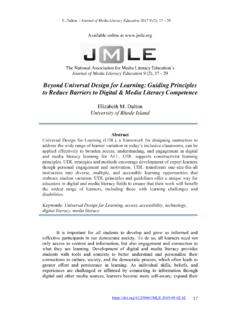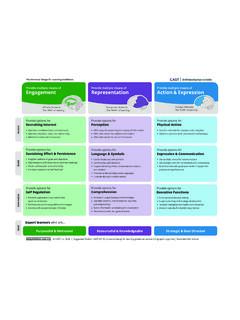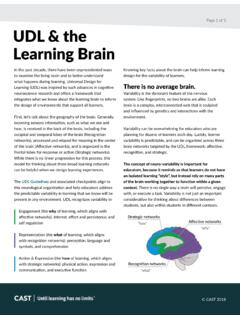Transcription of Preparing Teachers to Use Universal Design for Learning …
1 Journal of Online Learning Research (2018) 4(2), 147-171 Preparing Teachers to Use Universal Design for Learning to Support Diverse LearnersANYA EVMENOVAG eorge Mason University, Design for Learning (UDL) is a scientifically-based framework for developing curricula that acknowledges learner diversity as a function of human variability. While it is possible to implement UDL without advanced technolo-gies, it is easier and more efficient to provide multiple means of engagement, representation, and action/expression with technological support. In this exploratory study, 70 educators (including in-service general and special education Teachers ) learned about UDL implementation in an online course de-signed using UDL principles. At the end of the study, all edu-cators could recognize specific UDL guidelines and check-points in the observed lessons across grade levels and subject areas.
2 They also proposed revised lesson plans that extended the use of UDL to address the specific Learning outcomes and learner variability. The thematic analysis was conducted to explore the most common ways to use no technology to high technology tools, providing UDL through blended Learning . The findings from this study suggest the importance of mod-eling UDL practices to encourage implementation in class-rooms. Keywords: Universal Design for Learning , learner variability, online teacher preparation, professional development, teacher learning148 EvmenovaToday s classrooms are characterized by ever-growing diversity. In one instructional setting students with disabilities, gifted students, English lan-guage learners, and students who are culturally and linguistically diverse learn side-by-side. Individual students engage in Learning and reach mastery in different ways (Meyer, Rose, & Gordon, 2014).
3 This variability makes it important to Design instruction beneficial to all students. Universal De-sign for Learning (UDL) is a scientifically based framework for developing curricula that support a broad range of learners. The framework was intro-duced in the 1990s by the Center for Applied Special Technology (CAST; Edyburn, 2013). The concept of Universal Design originated earlier in archi-tecture, where physical environments were designed to be accessible to all users regardless of their abilities and needs (Mace, 1997; Rao & Tanners, 2011). When applied to pedagogical practices, it is the teaching and learn-ing that are designed to be accessible to students with and without special needs (Rao, Edelen-Smith, & Wailehua, 2015). Overall, the principles of UDL are built on the redundancy effect al-lowing for clarity and easier comprehension of instruction (Rose, Meyer, & Hitchcock, 2005).
4 This focus on redundancy is reflected in three overarch-ing principles: (1) multiple means of engagement; (2) multiple means of representation; and (3) multiple means of action/expression (CAST, 2017; Rose & Meyer, 2002). In other words, Teachers should use multiple ways to motivate students to learn; present content in multiple ways; and allow students to demonstrate what they know in multiple ways. These principles are supported by neuroscience and research on the cognitive Learning pro-cess. Cognitive accessibility relates to the processes taking place in the three primary brain networks: affective networks responsible for motivation and setting the priorities; recognition networks responsible for gathering and analyzing information; and strategic networks responsible for planning and executing actions (Dell, Dell, & Blackwell, 2015; Meyer et al.)
5 , 2014; Rob-inson & Wizer, 2016; Rao et al., 2015). UDL helps provide instruction minimizing the need for individual ac-commodations (Black, Weinberg, & Brodwin, 2014; Rao & Tanners, 2011). While some students with more intense needs may still require additional supports, most learners needs are addressed by the flexible curricula. Teachers are encouraged to analyze learner variability to proactively and in-tentionally build in flexible choices and scaffolds to predict and support the instruction for all up front, rather than making accommodations as an af-terthought. The iterative UDL Design cycle continues with implementation; reflection on what worked and what required change to further increase ac-cess; and lesson revisions as needed (Rao & Meo, 2016). Preparing Teachers to Use UDL149 UDL implementation is supported by a set of guidelines (Back et al.
6 , 2014). Across three principles of UDL, there are nine guidelines and 31 checkpoints (listed in Table 3). The checkpoints are developed based on the research-based best educational practices (CAST, 2011; Israel, Ribuffo, & Smith, 2014). While guidelines and checkpoints are somewhat prescrip-tive, they leave plenty of room for instructional creativity (Rao et al., 2015). UDL principles, guidelines , and checkpoints can be applied to any grade level, subject area, and Learning environment ( , face-to-face or online; Rao, Ok, & Bryant, 2014). There is no required number of checkpoints that need to be included for the instruction to be considered UDL-based (Rao et al., 2014). For example, Smith (2012) used a few strategies to address just one guideline providing options for recruiting interest while Kumar and Wideman (2014) offered a plethora of supports across three UDL principles.
7 The Design depends on the specific Learning environment, learner variabil-ity, and barriers within that environment (Rao & Meo, 2016). To summarize, UDL offers guidance for developing flexible goals, methods, materials, and assessments recognizing the variability in students abilities, needs, prefer-ences (Robinson & Wizer, 2016).UDL and Advanced TechnologiesUDL allows creating educational settings inclusive of all students, not just students with disabilities (Back et al., 2014). While it is possible to implement UDL without advanced technologies, various assistive and instructional technologies make it easier and more efficient to achieve the redundancies (multiple means of engagement, representation of content, and action/expression) (Dell et al., 2015). Meaningfully-integrated technol-ogy makes Learning environments more accessible to the diverse learners.
8 Indeed, technology can provide many seamlessly built-in, cost-effective supports (CAST, 2011). Online and blended Learning are great platforms for UDL implementation. Various multimedia tools, social media, and in-teractive websites facilitate the development of technology-enhanced UDL environments. Existing research that reports gains in students academic outcomes in all major content areas because of UDL-based interventions includes the use of such technologies as content acquisition podcasts ( , Kennedy, Thomas, Meyer, & Alves, 2014); videos and narrated presenta-tions (King-Sears et al., 2015); digital backpacks ( , Basham, Meyer, & Ernest, 2010); video games ( , Marino et al., 2014); and computer-based reading programs (Hall, Cohen, Vue, & Ganley, 2015). Teachers are encour-150 Evmenovaaged to incorporate technology in the UDL Design cycle to enrich any learn-ing environment and ensure success of all learners (Castleberry & Evers, 2010; Coyne, Pisha, Dalton, Zeph, & Smith 2012; Lock, Altowairiki, Hill, & Johnson, 2016; Rao & Meo, 2016).
9 UDL and teacher PreparationTo increase awareness and implementation of UDL, previous re-search has explored how UDL can be modeled in the face-to-face, hybrid, and online teacher education courses (Ashman, 2010; Coy, Marino, & Se-rianni, 2014; He, 2014; Parker, Robinson, & Hannafin, 2008; Rao & Tan-ners, 2011; Scott & Temple, 2017; van Laarhoven, Munk, Lynch, Bosma, & Rouse, 2007). Most of this research focuses on changing the perceptions of teacher educators towards implementing UDL in their Learning environ-ments. For example, Engleman and Schmidt (2007) designed a course about UDL using UDL principles. Thus, prospective Teachers had a chance to ex-perience UDL firsthand, resulting in deeper understanding of UDL and will-ingness to use it in their own classrooms. In addition to improved attitudes, even a brief exposure to UDL resulted in enhanced instruction for in-service educators in another study.
10 Both general and special education teacher can-didates increased the number of UDL strategies that they had incorporated in their lesson plans from pretest to posttest after just 1-hour training ses-sion (Spooner, Baker, Harris, Ahlgrim-Delzell, & Browder 2007). These findings were repeated in later studies (Courey, Tappe, Siker, & LePage, 2012; Navarro, Zervas, Gesa, & Sampson, 2016). However, researchers in these studies asked educators to develop lesson plans for hypothetical stu-dents presented in a case study. Thus, more empirical and authentic studies on how to translate UDL principles, guidelines , and checkpoints into prac-tice are needed (Rao et al., 2015). To develop a rich UDL-based online or blended environment, it is important to make sure that Teachers can bring to-gether concepts related to instructional objectives, learner variability, UDL strategies, and technology affordances that meet the needs of all students (Edyburn, 2010; Lock et al.)














